Explainer
- Explainer
- Science
'We're not running out of dinosaurs': Why is there a boom in fossils?
More than 20 years since Jurassic Park roared onto screens, interest in dinosaurs is not going out of fashion. What is Australia's dinosaur history? And what more is there to discover?
Jack Horner, the palaeontologist who inspired the movie juggernaut Jurassic Park, found his first dinosaur bone when he was just eight. His father had seen something sticking out of the earth as he rode across the prairies of Montana, North America, long the heartland of dinosaur discovery, and it was there that he took little Jack fossil hunting. The bone still sits in Horner’s office today.
The success of Jurassic Park in 1993 would launch a new generation of palaeontologists and an unprecedented boom for the field, opening up frontiers from Argentina to Australia and rewriting the story of the scaly monsters on screen. Within three years, on a hillside in China, a farmer had stumbled upon the world’s first glimpse of a feathered dinosaur.
Today, close to one new dinosaur species is discovered every week. This year the big find to hit headlines is a new species, and likely a new genus, of tyrannosaur exhumed from the dust of Alberta, Canada, pictured above.
Far from the image of the lumbering lizard doomed to extinction, palaeontologists now know dinosaurs as nature’s great success stories. In their 185-million-year reign on Earth, they weathered tremendous upheaval. Continents broke apart, volcanoes rained lava, temperatures and toxic gases climbed, monster wildfires scarred the land. Still dinosaurs spread to all its corners, growing to the size of passenger planes or emerging in strange new shapes including, eventually, as birds.
In South America and Asia, whole new ecosystems are being unearthed, from huge spiked herbivores to strange bat-winged “vampires”. In outback Australia, a literal treasure trove of fossils has been found down an opal mine, many species preserved as vibrant gems.
Now in another era of planetary change (this time of our own making), and with news from NASA that an asteroid nearly the size of the one that took out the dinosaurs 66 million years ago will soon sail hair-raisingly close to the Earth – what can we learn from these creatures? How has palaeontology evolved since Jurassic Park? What discoveries have put Australia on the map? And will we ever bring a dinosaur back to life?
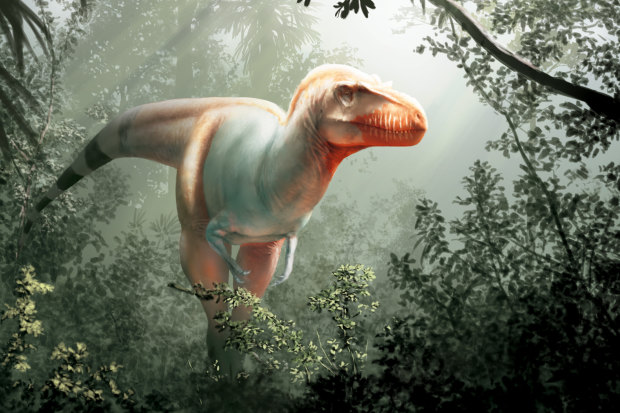
An artist's reconstruction of thanatotheristes or the Reaper of Death, discovered this year. Credit: Julius Csotonyi
Why are scientists still finding so many dinosaurs?
Horner sat next to director Steven Spielberg as a consultant on the set of Jurassic Park, and remembers well the hordes of students who suddenly signed up for his university classes after the film hit cinemas. But it wasn't a flash in the pan, says palaeontologist and author Steve Brusatte, who has himself helped discover somewhere in the order of 15 to 20 new dinosaurs.
The students kept coming and today the resulting gold rush of discovery shows no signs of slowing down. "We're not running out of dinosaurs," Brusatte laughs.
Palaeontologist Alfio Alessandro Chiarenza has tracked the rate of new finds since the first bones were unearthed in the 1800s, including that sudden surge. He too belongs to the Jurassic Park generation, the scientists "who never grew up", but says better technology is also speeding up dinosaur hunting as they compare finds online.
Out in the field, Horner says the tools are still mostly what they were when he started. Dinosaur bones eventually become rock (and in some places, such as Australia, gem stone), which makes them nearly impossible to pick out from the landscape with scanners. Yet, back in the lab, X-rays, 3D printing, even molecular particle accelerators now come into play. "And we can send drones out for us now to take pictures,” Horner says.
All of those fresh eyes in the field can sometimes catch what has been missed. This year’s new tyrannosaur on the block gathered dust in a museum cabinet for almost a decade before PhD student Jared Voris decided to take a closer look. Now dubbed the Reaper of Death, the tyrannosaur is the oldest found in Canada. In life, it would have been about the length of two cars.
"We're confident it's a new genus as well as a new species," Voris says. "The ridges in the jaw and the [shape of] the cheekbones are really different."
But sometimes, Horner warns, the hype can get ahead of the science. Many dinosaurs vary wildly in size and shape over their life cycle and baby dinosaurs have on occasion been "discovered" as their own separate species.
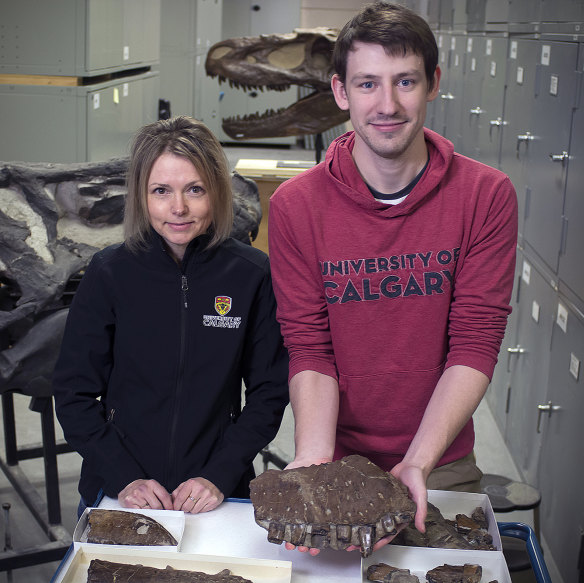
Darla Zelenitsky and Jared Voris with the bones he dusted off and identified as a new genus of dinosaur known as the Reaper of Death. Credit: Royal Tyrrell Museum
How do fossils form?
To survive the tens of millions of years between death and discovery, dinosaur remains need cover from the elements. Most will decay completely but sometimes the conditions are just right for preservation - usually when an animal dies near water and is buried under sediment such as mud or silt. Water infused with minerals will seep into the hard, longer-wearing parts, the bones or teeth, as they break down, gradually replacing and encasing them. Over millennia, they are compressed into rock or "fossil". Sometimes other substances such as tar or ice can do an even better job of preserving the original remains, leading to remarkable discoveries such as intact feathers or even soft tissue.
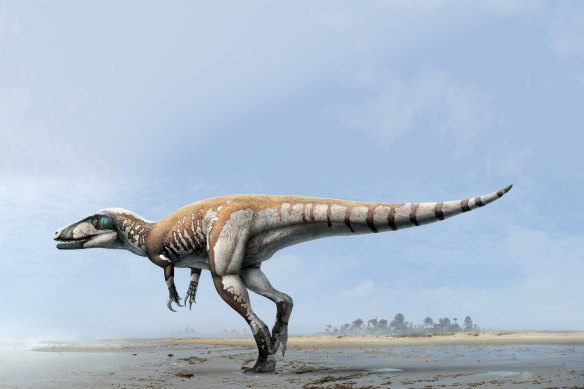
An artist's impression of the seven-metre-long Lightning Claw, the largest carnivorous dinosaur found in Australia.
What is Australia's dinosaur history?
On Australia's west coast, some of the world's largest surviving dinosaur footprints are still in the rock, spanning almost two metres each. But it is on the east coast that most of Australia's fossil record is being dug up – and it's taken a “quantum leap forward” in the past few years, according to the Australian Museum.
One hundred million years ago, in the last great age of dinosaurs known as the Cretaceous period, the dry continent was lush and green. Pterosaurs or “iron dragons” ruled the skies and ancient crocodiles shared hunting grounds with creatures such as Lightning Claw, pictured above, the largest carnivorous dinosaur ever found in Australia, with its "grappling hooks" for hands. Much of the east was swamped by a shallow inland sea – creating the perfect conditions for fossils.
“It seems to be the only place in the world where the dinosaur fossils have turned to opals so it’s literally a treasure trove."
While our most complete dinosaur skeletons have come from Queensland, opal miners in remote NSW have stumbled upon the most beautiful. Down a mine shaft in Lightning Ridge is one of the richest fossil collections ever discovered from Gondwana, the ancient supercontinent that once accounted for two-thirds of today’s land, including Australia. Here, dinosaur remains were buried under reactive minerals – glass or silica ash – from a chain of volcanoes erupting up north near the Great Barrier Reef at the time. Under the "Martian-like" conditions, the most unique opals in the world took shape in the rock – and in dinosaur bone.
“It seems to be the only place in the world where the dinosaur fossils have turned to opals so it’s literally a treasure trove,” laughs Phil Bell, a palaeontologist at the University of New England. "Some species have rich veins of colour through them, blues and reds."
Fossils have been picked out of opal hauls since mining began at the site in the 1900s – Australia's first prehistoric mammals were discovered there as well as some dinosaur species. But it’s hard work, climbing metres down rickety ladders into black chasms to dig with pick axes and jackhammers. Most of what’s been found has come off the back of the miners themselves. Even then, no one had studied the fossils in depth until 2013, when Bell ventured into the dark beneath Lightning Ridge and found a wealth of life, including Lightning Claw and an entire herd of the plant eater Fostoria.
"Not all of the bones are gem-quality, a lot are just the dark or opaque part of the opal, but some of those Fostoria bones do shimmer with the entire spectrum of colours," Bell says. "These things are worth tens of thousands of dollars as jewellery but they're priceless as fossils."
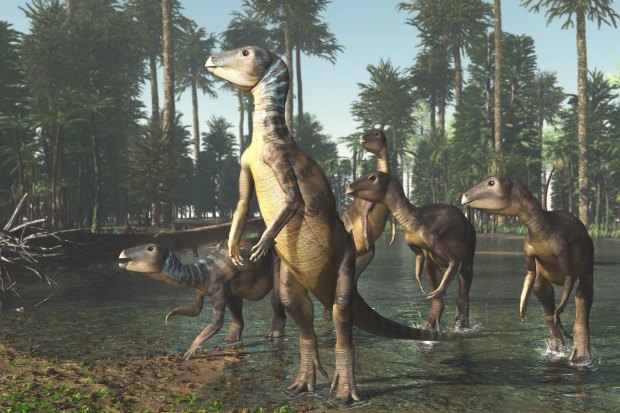
An artist's impression of a Weewarrasaurus identified by Phil Bell and his team at Lightning Ridge in Australia. Credit: James Kuether
They are so precious that palaeontologists and the Australian Opal Centre are working with the local mining community to save them from commercial trade. When broken up for their gems, the fossils fetch a decent sum. But in a region hit hard by drought, they can bring more value, the argument goes, as a tourist attraction.
"Until Lightning Ridge, we'd been dealing with [bones] from Victoria's coast and Queensland," Bell explains. "We had those beautiful big [sauropod] tracks in Broome but that was our sole image of what dinosaurs in Australia looked like. Suddenly, here was this virtually untapped window into our past."
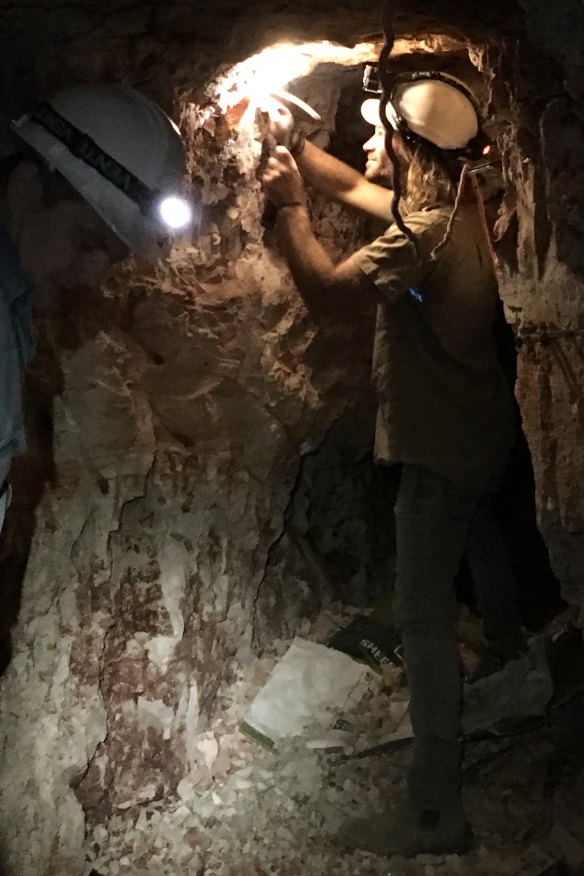
Paleontologist Phil Bell excavating for opalised fossils in the Lightning Ridge mine.Credit: Phil Bell
Is there a black market in dinosaur bones?
It's not only scientists looking for dinosaurs. While "bone wars" have been raging since the 1800s, as paleontologists and collectors haggled over finds, the field's technology boom has also made it easier for black market traders to beat researchers to sites. Of course, a lot of dinosaur hunting depends on whose land you're on and regulation varies between countries and states. In Canada, all discoveries are the property of the Crown. In much of Australia and other parts of the world, if the bones are found on private land, they belong to that landowner. If they are held in a private collection, they are considered scientifically worthless as they cannot be studied by others.
Like a rare Rembrandt, T-Rex skeletons and other fossils are fast becoming status symbols and stolen bones routinely surface at high-profile auctions with forged paperwork. A bidding war reportedly broke out between actors Nicolas Cage and Leonardo DiCaprio over a $276,000 dinosaur skull. Cage won but had to return the skull in 2015 when it emerged it had been smuggled illegally out of Mongolia, a mecca for fossils but also a hot spot for dinosaur crime, Bell warns. He is one of a growing number of paleontologists now using hand-held Star-Trek style scanners "a bit like hairdryers" to trace the chemical fingerprints of bones and so help determine where they might have been poached from. In Australia, our rare opalised fossils cannot be exported without a permit (which are hard to come by). But their rarity makes them highly sought after on the black market.
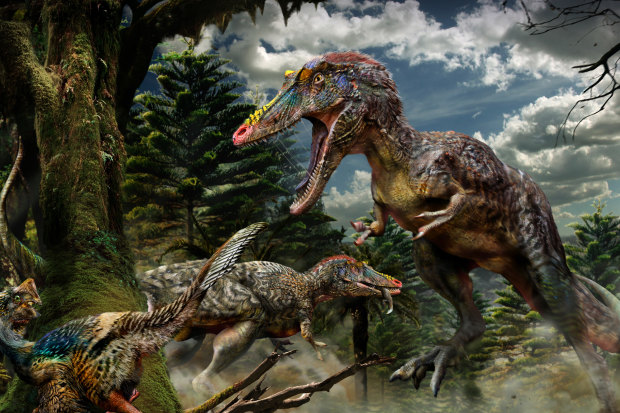
China's long-snouted tyrannosaur Qianzhousaurus, nicknamed Pinocchio Rex.Credit: Zhao Chuang
How do we know what dinosaurs looked like?
As palaeontology itself evolves, dig sites are becoming less of a graveyard and more of a crime scene. Researchers hunt for clues that will tell them not just the kind of animal they've found but how it lived. Dinosaurs, like sharks, shed their teeth often, Bell says, and in sites such as Lightning Ridge, palaeontologists can piece together whole ecosystems. X-rays can help them look inside dinosaur brains and see where arteries once carved around the bones. Fossils can be 3D printed, and species run through the same engineering software used to test the structural integrity of dams and bridges to explore how they would have moved, if they could fly, the way T-Rex really handled those tiny arms.
The newly unveiled tyrannosaur find also provides clues about the ecology of North America during the Cretaceous period – further evidence, according to Voris, of an apparent split in the land between 89 million and 74 million years ago.
“In the north, Montana, Alberta, we see really different species to further south, like Utah, alive at the exact same time but there's nothing in the land so far we've found to tell us why,” he says. “We have to keep digging.”
Above: A new species of raptor, Zhenyuanlong, which Brusatte helped discover in China and an impression by Zhao Chuang of the creature, which couldn't fly.
In parts of the world such as China, whole areas have been preserved under almost Pompeii-like conditions by past volcanic eruptions or sudden floods, allowing scientists to find remarkably well-preserved feathers. Under X-rays, they've even extrapolated the colour pigments, turning the old drab green and brown dinosaur palette on its head in an explosion of flamboyant blues, reds and yellows. Given feathers appeared on many species too big to fly, Brusatte says it’s likely the filaments didn’t evolve for the purpose of taking to the skies and might have first been used in mating display.
But while feathers on species such as velociraptor were met with a lot of fanfare (some museum collections changed their exhibits overnight), elsewhere scientists such as Bell have examined the scaly skin of a T-Rex.
“The hype around feathers kind of steamrolled a lot of other evidence,” Bell says. “There were lots of feathered dinosaurs but we still [think] most had scaly skin.”
Of course, just as it would be difficult to discover from skeletons many of the wonders of the natural world today, from whale song to lyrebird mimicry, Chiarenza says there are things palaeontology will likely never know.
"Because of the way fossils form, we'll probably never find animals that lived in the mountains," he says. "There might have been all kinds of strange creatures there, like we have gorillas and [big cats] today."
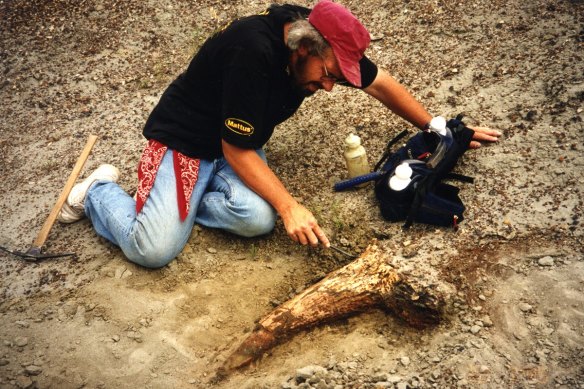
Jack Horner digging up a triceratops in Montana.Credit: Jack Horner
What more is there to discover?
The holy grail of palaeontology is still dinosaur DNA. It was Horner's own research on dinosaur babies that helped inspire Michael Crichton to write Jurassic Park – Sam Neill would go on to play the role based on Horner, Dr Alan Grant, in the film adaptation. While Horner didn’t meet Crichton until they were both pressed into the back of a limousine en route to its premiere, the author’s wild idea – that dinosaur DNA could be extracted from ancient preserved mosquitoes – lit the fuse for his next phase of research: could we really build a dinosaur?
DNA breaks down fast, even in the belly of a mosquito, and the amount needed to create a dinosaur would be much more than palaeontologists could ever dream to find, Horner says. Still, there have been flashes of hope over the years, including the breakthrough discovery of soft tissue and intact blood proteins in a T-Rex bone by his student Mary Schweitzer.
Birds are the dinosaurs that escaped extinction. Their genes still carry the building blocks of ancient dinosaurs – but many of their dino traits have been “turned off” over the course of evolution.
But Horner has a Plan B: one he’s dubbed "chickenosaurus" for the school kids. Birds are the dinosaurs that escaped extinction. Their genes still carry the building blocks of ancient dinosaurs – but many of their dino traits have been “turned off” over the course of evolution. Just as there have been rare cases of humans born with a tail or a snake with legs, Horner’s plan is to flick back on the dormant lines of genetic code in a chicken.
“We've found the genes we need to turn back on to change the head, the arms, the legs, to grow teeth," Horner says. "But we can't figure out how to make the tail. That doesn't seem to be a [dormant or] atavistic gene."
That means the team will now have to turn to high-tech genetic engineering tools, likely the DNA editor CRISPR--Cas9, to finish the job and "keep the fourth-graders happy". "But getting university backing to use a new tool like that, to create a novelty, it's not going to happen soon," Horner says.
When it comes to solving the mystery of what killed the dinosaurs, meanwhile, scientists have almost closed the case. The suspect pool has now been mostly whittled down from volcanoes, toxic gases and even chronic constipation, to a world-shattering asteroid hit one June day 66 million years ago. The chunk of rock to blame was at least 10 kilometres wide and it hit with the force of more than a billion nuclear bombs, punching a hole in the Earth's crust in what is now the Gulf of Mexico.
It also exposed, according to many in the field, the vulnerability of any biological empire on Earth – including humanity. With the world today facing threats from human-induced global warming and large-scale species extinction, and now another deadly virus, NASA has offered yet more sobering news: an asteroid almost as big as the dinosaur killer will shoot past Earth in a matter of weeks. We'll escape harm, but it'll be a near thing in astronomical terms.
Horner says that while the importance of studying dinosaurs "might still be lost on some people" they can tell us more about the world than ever before, a glimpse into both evolution and extinction.
"The key to our future is in the past – and dinosaurs are a huge part of that."
Let us explain
If you'd like some expert background on an issue or a news event, drop us a line at explainers@smh.com.au or explainers@theage.com.au. Read more explainers here.